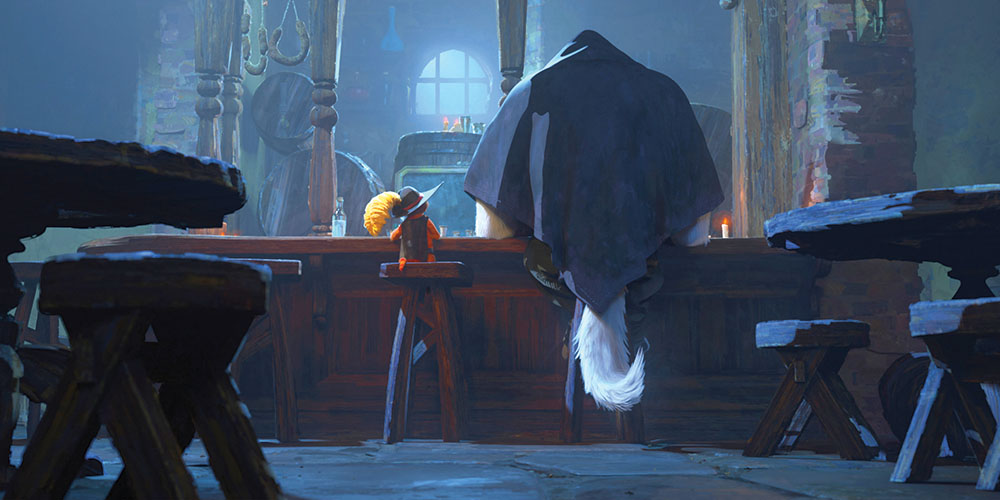
Puss in Boots (Antonio Banderas) meets the Wolf (Wagner Moura) at a bar over a glass of milk, but swordplay quickly ensues.
Courtesy of Dreamworks Animation

Made a decade after 2011’s Oscar-nominated Puss in Boots, the sequel that debuts Dec. 21 takes a darker turn as the eponymous feline, voiced by Antonio Banderas, is forced to confront his mortality. “He’s burned through eight of his nine lives, and he’s on his last,” director Joel Crawford says, explaining that while a cat’s nine lives make for a fun premise, the filmmakers used it to talk about a more serious subject. “You have one life, how are you going to live it? That’s such a powerful theme that’s relevant for everybody.”
He adds that Dreamworks Animation’s Puss in Boots: The Last Wish aims to deliver “what everyone was expecting: the swashbuckling fun of a Puss in Boots, but also expand the world, even in the look.” The story begins with a song and playful action sequence. After an unfortunate accident, Puss gets news from his doctor that he’s on the last of his nine lives, which he brushes off, then retreats to a bar for a glass of leche. There, he’s confronted by the Wolf, a bounty hunter (who later reveals he is Death himself), and a sword fight ensues.
For the pivotal sequence, Crawford and co-director Januel P. Mercado took some influence from Sergio Leone’s spaghetti Westerns and Akira Kurosawa’s films. “This is the moment where it gets gritty and everything changes tone. You get quicker cuts in the action, you get longer moments of pause, much like a Western,” Crawford says. “The moment where Puss gets cut [by the Wolf’s blade], Januel did this close-up of Puss’ eyes — it’s the Sergio Leone close-up — and then he did that little drop of blood running down his head.”
That’s the moment that we see Puss’ emotion change as he realizes the stakes of his situation. “It’s a surprisingly dark scene,” says head of story Heidi Jo Gilbert. “Most of the audience isn’t expecting to go in and see that dark of a scene in a Puss in Boots movie.” Crawford adds that it was editor Jim Ryan’s idea to create the moment when Puss’ lives flash before his eyes.

Puss in Boots (Antonio Banderas) meets the Wolf (Wagner Moura) at a bar over a glass of milk, but swordplay quickly ensues.
Courtesy of Dreamworks Animation
Viewers will notice a new visual style, which production designer Nate Wragg says was aimed at making the movie “feel like a contemporary fairy tale,” conceived by researching a more “impressionistic approach” to painting.
“The Puss in Boots character before the Shrek franchise was born out of fairy tales, and the Shrek franchise [the first film, 2001’s Shrek, won the first Oscar for best animated feature] has a lot of fun in that creative space,” he explains. “When those movies were created, what we could do really well in CG animation was a more naturalistic feel.” He says with the latest computer animation software (including some written by DWA for The Last Wish), “we’re able to bring a different creative vision to the computer and up onto the big screen. Rather than focusing on a naturalistic feeling for the world, [we] really [tap] into an illustrated, fantasy, fairy-tale experience for the audience, to help bring it back to its early roots — but then with all the amazing bells and whistles, if you will, that we can apply with [today’s] tools.”
This is evident in the bar moment between Puss and the Wolf. Explains Crawford, “The point of the scene was to have Puss feel fear and be aware of his mortality for the first time. Being able to express that, not literally but impressionistically, was like having another tool in our toolbox.”

Puss in Boots (Antonio Banderas) meets the Wolf (Wagner Moura) at a bar over a glass of milk, but swordplay quickly ensues.
Courtesy of Dreamworks Animation
This story first appeared in the Dec. 16 issue of The Hollywood Reporter magazine. Click here to subscribe.